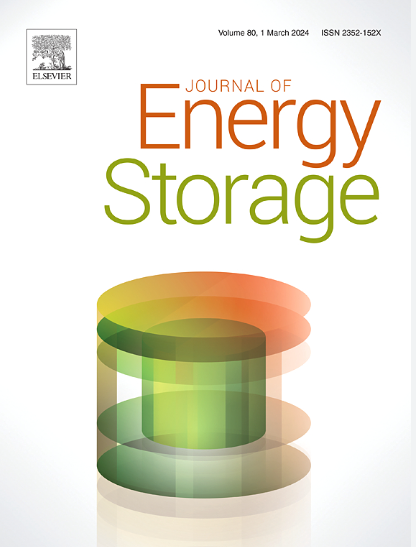电池老化历史对NMC 622袋式电池未来降解率和容量恢复效果的影响
IF 8.9
2区 工程技术
Q1 ENERGY & FUELS
引用次数: 0
摘要
预测锂离子电池的健康状态(SoH)对于优化锂离子电池的利用至关重要。虽然电化学降解模型和数据驱动的方法在SoH估计方面很有前景,但它们往往依赖于重复的理想循环和延长的松弛期的实验,导致动态现实条件下的模型不具有鲁棒性。本研究提出了一个关于不同循环序列(老化历史)如何影响未来降解率和SoH估计的新研究。在一个独特的实验设计中,四个相同的汽车级NMC袋状电池最初受到不同的加速循环条件,然后采用共同的方案,直到降解曲线通过其膝盖点。对容量演变、膨胀和表观容量衰减进行了详细分析。结果表明,为了实现动态条件下的鲁棒性和提高系统安全性,在SoH建模中必须考虑老化历史。在某些情况下,膝点发作延迟至少50%,而在其他情况下,根本没有发生。此外,可逆的短期容量衰减强烈依赖于电池的状态,新鲜电池表现出大约15%的下降,在测试活动结束时逐渐下降到1%左右。这些发现强调了从基于实验室的SoH模型过渡到现实世界中适用的SoH模型的关键考虑因素。最后,膨胀与SoH有很强的相关性(R2 = 0.97),因此是一个有价值的替代SoH指标,特别是在无法在可重复条件下进行可控容量检查的在线在线评估技术中。本文章由计算机程序翻译,如有差异,请以英文原文为准。
Impact of battery ageing history on future degradation rates and capacity recovery effects in NMC 622 pouch cells
Predicting the state of health (SoH) of Lithium-ion battery cells is essential for optimizing their utilization. Although electrochemical degradation models and data-driven approaches are promising for SoH estimation, they often rely on experiments with repeated idealized cycles and extended relaxation periods, leading to non-robust models for dynamic real-world conditions. This study presents a novel investigation on how different cycling sequences (ageing history) influence future degradation rates and SoH estimation. In a unique experimental design, four identical automotive-grade NMC pouch cells were initially subjected to different accelerated cycling conditions, followed by common protocols until the degradation curve passed its knee point. A detailed analysis was conducted on capacity evolution, swelling and apparent capacity fade. Results indicate that ageing history must be considered in SoH modelling, to achieve robustness under dynamic conditions and improve system safety. Under some conditions, the knee point onset was delayed by at least 50%, while in others, it did not occur at all. Additionally, reversible short-term capacity fade is strongly dependent on the cell’s state, with fresh cells exhibiting a drop of approximately 15% which gradually decreases to around 1% by the end of the test campaign. These findings highlight key considerations for transitioning from laboratory-based to real-world applicable SoH models. Finally swelling shows strong correlation with SoH ( = 0.97), and is therefore a valuable alternative SoH indicator, especially in online in-service estimation techniques where controlled capacity checks under repeatable conditions are not available.
求助全文
通过发布文献求助,成功后即可免费获取论文全文。
去求助
来源期刊

Journal of energy storage
Energy-Renewable Energy, Sustainability and the Environment
CiteScore
11.80
自引率
24.50%
发文量
2262
审稿时长
69 days
期刊介绍:
Journal of energy storage focusses on all aspects of energy storage, in particular systems integration, electric grid integration, modelling and analysis, novel energy storage technologies, sizing and management strategies, business models for operation of storage systems and energy storage developments worldwide.
 求助内容:
求助内容: 应助结果提醒方式:
应助结果提醒方式:


